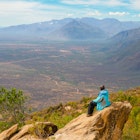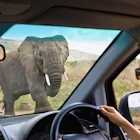
Apr 28, 2025 • 4 min read
With a 4WD self-drive safari in Southern and/or East Africa, you could spot elephants at dawn and enjoy a sunset campfire. Here's the scoop.

Apr 28, 2025 • 4 min read
With a 4WD self-drive safari in Southern and/or East Africa, you could spot elephants at dawn and enjoy a sunset campfire. Here's the scoop.

Dec 13, 2023 • 9 min read
Whether you want a weekend road trip from Nairobi or a scenic self-drive in the north, we've got the best road trips in Kenya for you.

Nov 30, 2023 • 9 min read
You don't have to break the bank to explore the incredible landscapes in Kenya – you just need our top tips to squeeze every penny out of your budget.

Nov 29, 2023 • 4 min read
Don't let your dream vacation to Kenya go wrong before it starts. We've got everything you need to know about securing a tourist visa before you jet off.

Nov 21, 2023 • 7 min read
What do you need to know before visiting Kenya? Is Nairobi safe? Do I need a visa? From passport requirements to cultural etiquette, we have the answers.

Nov 21, 2023 • 5 min read
Kenya is a wonderfully warm and welcoming destination for kids. From wildlife safaris to Maasai culture, a wealth of great experiences awaits your family.

Nov 19, 2023 • 10 min read
Travel from the cities to the coast and national parks with this guide to getting around in Kenya.

Nov 17, 2023 • 7 min read
From the Great Migration and the best diving conditions to vibrant festivals across Kenya, our guide will help you pick the perfect time for your visit.

Aug 4, 2023 • 6 min read
A recent trip to Kenya left Lonely Planet creative director Annie Greenberg “gobsmacked.” Here’s why.

Jun 30, 2023 • 4 min read
Expert guide Steve Nkumum knows everything there is to know about the Maasai Mara ecosystem, thanks to his formal education and personal experience.

Apr 4, 2023 • 13 min read
Kenya has a whopping 23 national parks. These are the best.

Mar 24, 2023 • 8 min read
It’s easy to forget that Kenya has some wonderful hiking trails. Here are 9 of the best.

Oct 14, 2022 • 9 min read
Kenya's complex history is reflected in its incredibly diverse cuisine. Here's the ultimate guide to drinking and dining in Kenya.

Jul 27, 2022 • 8 min read
Safaris may be the big attraction in Kenya, but don't overlook the beaches. From Mombasa's resorts to Lamu's rolling dunes, here's a guide to the best.

Jun 10, 2022 • 8 min read
Peter Elia headed to Mt Kenya in search of a less crowded alternative to Kilimanjaro, and found he had Africa's second-highest mountain almost to himself.

Oct 3, 2020 • 12 min read
In this travel essay from 2011, Amanda Canning reports on the archipelago of Lamu, just off the coast of Kenya, where medieval stone streets trace a history…

Sep 30, 2020 • 6 min read
Companies committed to the conservation of wildlife are utilizing AI to improve the efficiency and effectiveness of a growing number of sustainable programs…

Sep 17, 2020 • 6 min read
Kenya is a country of epic landforms that stir our deepest longings for this very special continent. Here are our favorite natural wonders.

Dec 16, 2019 • 5 min read
Amboseli is one of the best places in Africa to see wildlife. Here, we looking into its riches and the incredible conservation work that is taking place.

Oct 31, 2019 • 6 min read
When it comes to planning a safari in Africa, there is one big question you need to answer before starting. Are you ready for a self-drive safari?

Oct 22, 2019 • 5 min read
If you’ve never before been on safari in Africa, you may wonder how your days will be spent. Here we run down what you can expect, from dawn to nightfall.

Jul 22, 2019 • 6 min read
A week at an all-inclusive resort promises idle, sunny days but it doesn’t usually spell adventure. After all, where’s the thrill of exploration when…